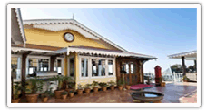|
|
|
| |
| |
Travel destination in India, Ahemdabad |
|
| |
Ahmedabad :
Area : 1,300 sq. km.
Altitude : 55 meters.
Language : Hindi, English and Gujrati.
Best Time to Visit : Winters.
State : Gujrat.
Location : 34 Km from Kathgodam, 304 km from Delhi and 388 km from Lucknow.
STD Code : 079. |
About Ahmedabad
Ahmedabad the largest city in Gujarat blends an ancient heritage with a vibrant present. It nurtures in its pages of history, a breath of harmony and a show-case of exquisite harmony. The city is named after a Sultan who founded it in 1411 and graced it with splendid monuments. Ahmedabad is also known for its association with the Apostle of peace Mahatma Gandhi whose ashram is on the banks of River Sabarmati which is now a national pilgrimage site.
One of the most liveliest cities in India. A visit to Ahmedabad is a great way to discover Gujarat. Ahmedabad was built by Sultan Ahmed Shah to serve as his capital in 1411 A .D. While returning from one of his campaigns the young Sultan Ahmed Shah impressed with the scenic surroundings and climate of the town of Ashawal undertook the building of his new capital with a fort and twelve gates and named it Ahmedabad. While you can only see the ramparts of the 600 year old Bhadra fort, almost all the twelve gates with the exception of one have withstood the ravages of time and man.
HOW TO REACH THERE
By Air : Accessible from both national and international routes, Ahmedabad airport is 10 km north of the Ahmedabad city. Regular flights operate to and fro from the city to various destinations like, Delhi, Mumbai, etc. both within and out of the country.
By Road : Ahmedabad is connected with several Indian states of Gujarat as Gandhinagar, Vadodra, Rajkot, Palitana and Jamnagar through a good road network.
By Rail : Ahmedabad city is well connected by trains with other Indian cities. Regular trains are available to Delhi, Mumbai, Vadodra and Udaipur.
MAIN ATTRACTIONS IN AHMEDABAD
• Teen Darwaza : Sultan Ahmed Shah built these arched gateways as the royal entrance to the Maidan Shah or Royal Square.
• Calico Museum : The Calico Museum of Textiles, widely regarded as one of the finest textile museums in the world was constructed in 1949. The Museum houses no less than five centuries of the finest fabrics spun, woven, printed and painted in different parts of India. It also has a collection of marble, sandstone and bronze icons and busts split in two thematic sections-gallery for religious textiles and historical textiles.
• Hussain-Doshi's Gufa : It is a gallery housing the collaborative efforts of artist M. F. Hussain and the architect B. V. Doshi. Here, art and architecture fuse to become a unique experience, both complementing each other magnificently. Located in the campus of the Centre for Environment Planning and Technology, the Gufa is a configuration of cave-like structures buried under the ground. This marvel of contemporary architecture was constructed using computer aided design and tribal initiative.
• Kankaria Lake : Created by Qutb-Ud-Din in 1451, the Kankaria Lake is surrounded by gardens. It has a zoo, an aquarium, and a children's park. In the middle of the lake is an island palace that has 34 sides, each side is 60 metre long.
• Gandhi Ashram : During the lifetime of Mahatma Gandhi it was known as Satyagraha Ashram and was the centre of the struggle for Independence. It was from here, in 1930, that the Mahatma started on his famous "Dandi March" to the sea to protest against the Salt Tax imposed by the British. 'Hridaya Kunj', the simple cottage where he lived, is preserved as a National Monument. A Gandhi Memorial Centre, a Library and a Sound-and-Light show offer indepth insight into the Mahatma's life and work.
• Hatheesing Jain Temple : Intricate carvings on white marble, the Hatheesing Jain Temple is one of the finest Jain temples in Ahmedabad. A must see.
|
|
|
| |
|
|
|







